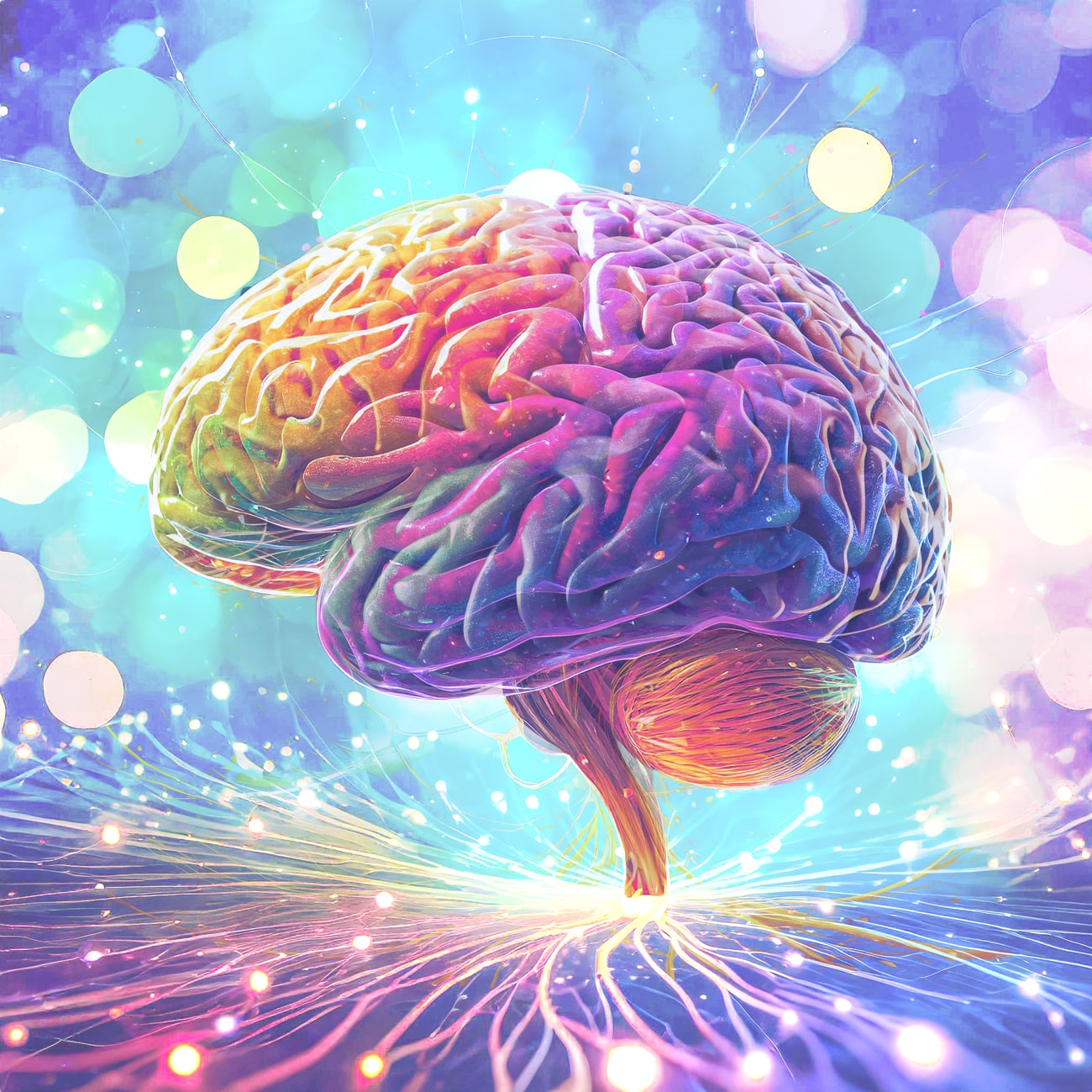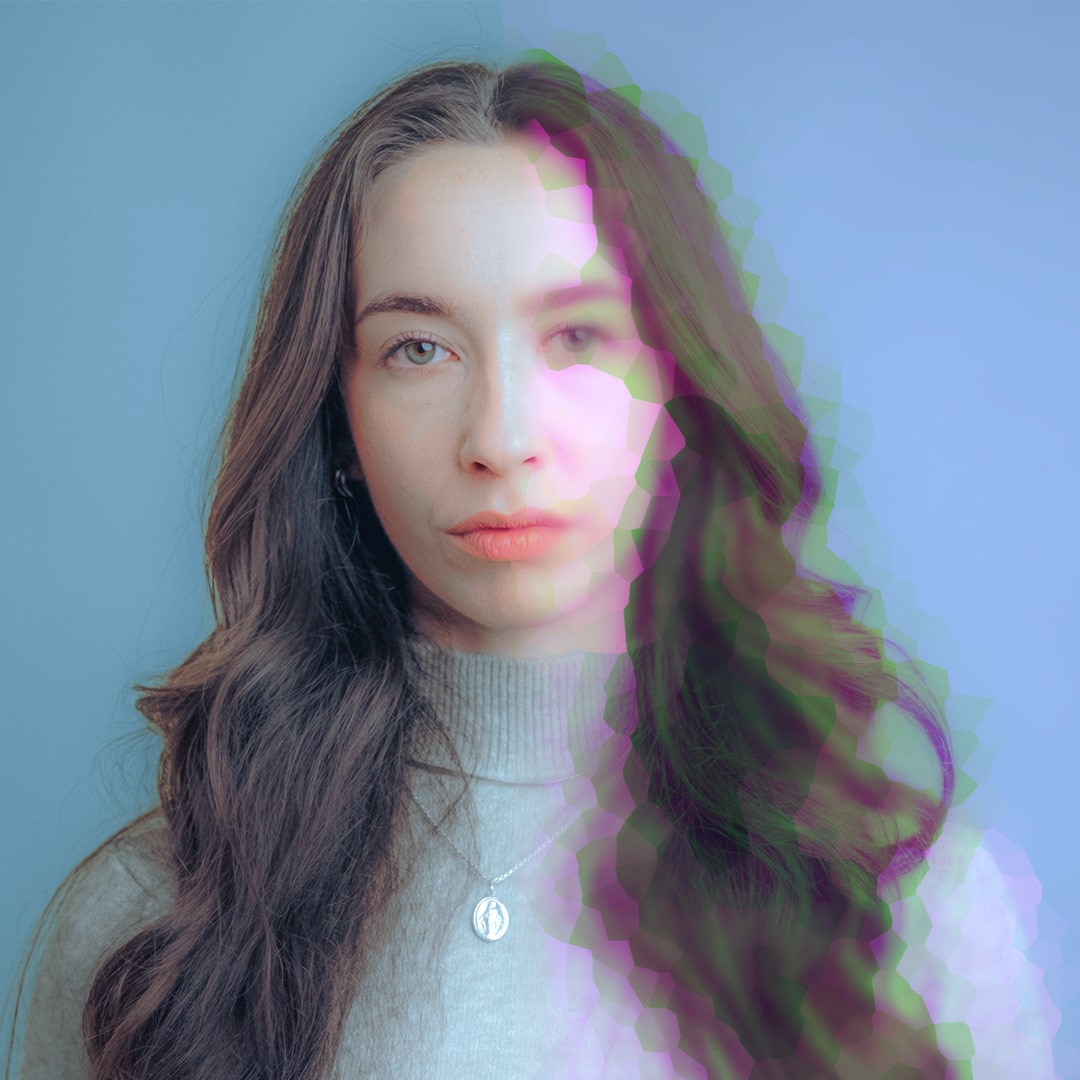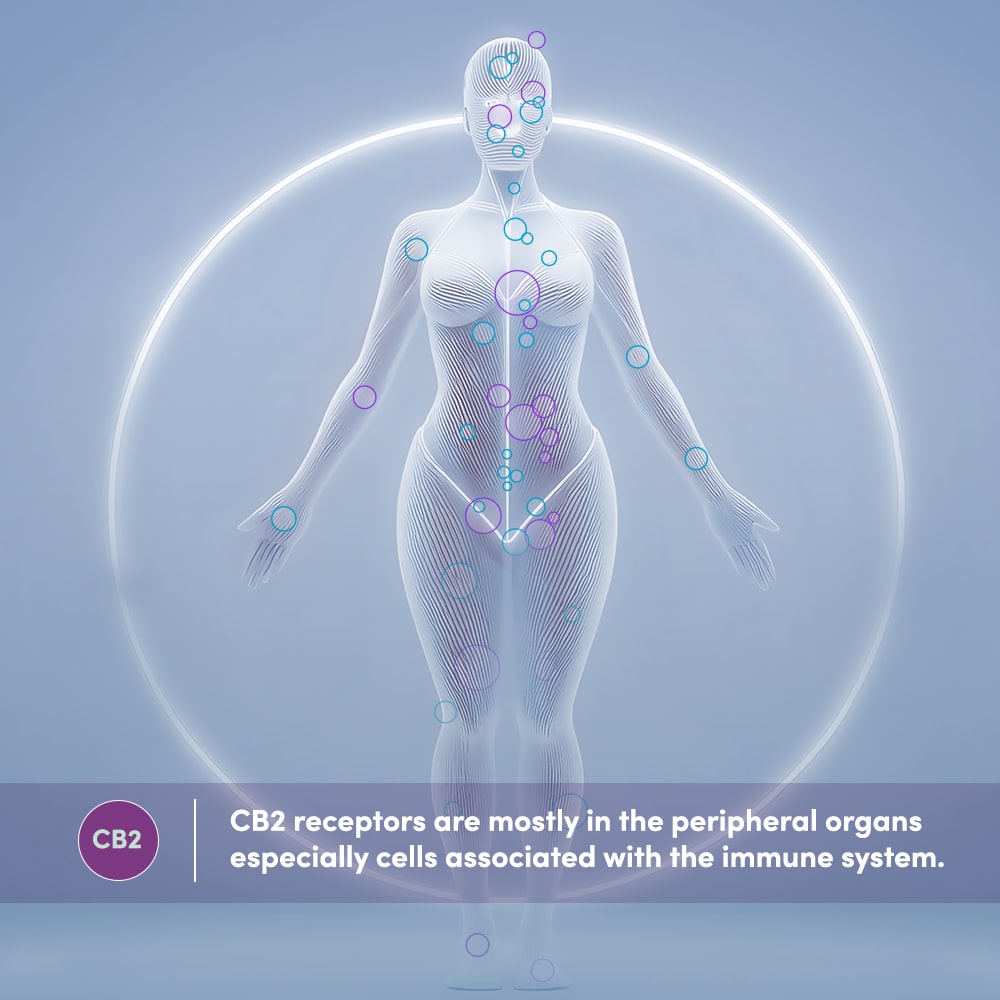
By: Juan Manuel Orjuela, MD
Neuropsychiatrist
Synesthesia is a remarkable way of perceiving the world, it is an experience where the properties of a stimulus or domain evokes different experiences not entirely related to the first domain. Examples of this phenomenon are when a person experiences musical notes or letters with colors or letters with sounds1. One attribute of a stimulus (e.g., its sound, shape, or meaning) may inevitably lead to the conscious experience of an additional attribute. For example, the word “Phillip” may taste of sour oranges, the letter A may be luminous red, and a C# note on the violin may be a brown fuzzy line extending from left to right in the lower left part of space.1
At least 60 variants of synesthesias have been described, including reports related to color, taste, touch, and sound. Although an exact prevalence has not been documented, it is estimated that approximately 4% of the population may experience some type of synesthesia.1 The first reported cases date back to 1800, but it is not until recent decades that the mechanisms and authenticity of synesthesias have been described, integrating the knowledge of cognitive neurosciences and the different aspects of cross-modal perception.1
At least 60 variants of synesthesias have been described, including reports related to color, taste, touch, and sound. Although an exact prevalence has not been documented, it is estimated that approximately 4% of the population may experience some type of synesthesia.1 The first reported cases date back to 1800, but it is not until recent decades that the mechanisms and authenticity of synesthesias have been described, integrating the knowledge of cognitive neurosciences and the different aspects of cross-modal perception.1

There are several ways to classify synesthesias. One of the most used divides them into: 1) congenital or developmental; 2) acquired; 3) induced by chemical substances.2
In the first case, according to the neonatal hypothesis of synesthesia, we may all have been synesthetes as babies due to increased functional connectivity in the infant brain. The incomplete pruning hypothesis proposes that synesthesia in adults is caused by incomplete synaptic pruning that has left unrelated neural connections intact.2 For example, if neural connections persist between the visual (occipital) and auditory (temporal) cortex, a person could experience the joint perception of listening to music and seeing colors. Typically, the developmental synesthete is unaware that he or she has this ability. They can reach adolescence or even adulthood without being aware that they are.2
Acquired synesthesias can also occur as a consequence of some type of brain injury (craniocerebral trauma, cerebrovascular events, etc.).2 For example, there is a case report of a 71-year-old previously healthy left-handed woman who developed synesthesia after suffering a traumatic head injury. The course was complicated by focal status epilepticus with imaging showing cortical edema. Soon after discharge, she reported symptoms of seeing colors projecting out of people’s mouth during oral speech, suggestive of chromesthesia. The colors were vivid in intensity at onset but would rapidly dissipate into vaporous appearance. For example, the word “the” was associated with the color blue.3
In the first case, according to the neonatal hypothesis of synesthesia, we may all have been synesthetes as babies due to increased functional connectivity in the infant brain. The incomplete pruning hypothesis proposes that synesthesia in adults is caused by incomplete synaptic pruning that has left unrelated neural connections intact.2 For example, if neural connections persist between the visual (occipital) and auditory (temporal) cortex, a person could experience the joint perception of listening to music and seeing colors. Typically, the developmental synesthete is unaware that he or she has this ability. They can reach adolescence or even adulthood without being aware that they are.2
Acquired synesthesias can also occur as a consequence of some type of brain injury (craniocerebral trauma, cerebrovascular events, etc.).2 For example, there is a case report of a 71-year-old previously healthy left-handed woman who developed synesthesia after suffering a traumatic head injury. The course was complicated by focal status epilepticus with imaging showing cortical edema. Soon after discharge, she reported symptoms of seeing colors projecting out of people’s mouth during oral speech, suggestive of chromesthesia. The colors were vivid in intensity at onset but would rapidly dissipate into vaporous appearance. For example, the word “the” was associated with the color blue.3
In relation to synesthesias induced by chemical substances, the best known are those associated with the consumption of psychedelics. Most of the research has involved LSD, mescaline, psilocybin, ayahuasca or MDMA. A common point between these substances is that they are all serotonin agonists, specifically 5HT-2A receptors, which are known to be involved in the phenomenological experiences of psychedelics.4
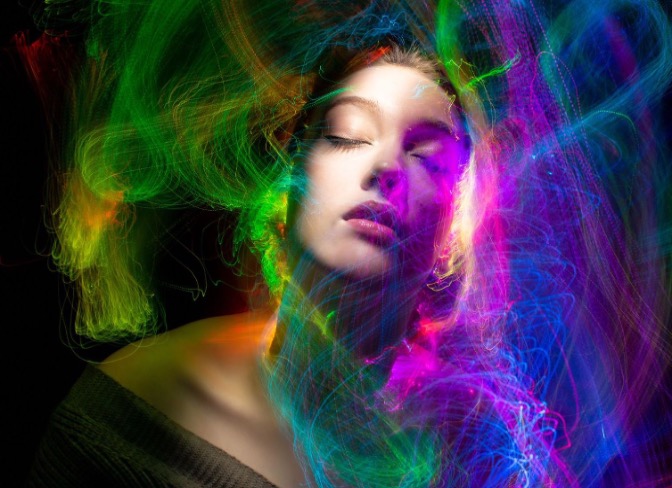
There are two main models that attempt to explain the neurobiology of synesthesias. The direct cross-activation model postulates that direct connections between sensory specific areas are responsible for co-activation and synesthetic perception. For example, if you hear music (temporal lobe) it can co-activate synchronous visual imagery (occipital lobe).
The second model, named the “hyperbinding model”, suggests that the inducing stimulus and the synesthetic sensation are coupled by a sensory nexus area, which may be located in the parietal cortex.5 This latter hypothesis is compatible with the disinhibited feedback model, which suggests unusual feedback from multimodal convergence areas as the cause of synesthesia.5
An interesting aspect is the relationship between synesthesia and creativity. Some studies show that synesthetes spend more time on creative activities compared to non-synesthetes. In the study mentioned below (Figure 3), it is evident that synesthetes dedicate more hours per week to creative activities (music syn).6
The second model, named the “hyperbinding model”, suggests that the inducing stimulus and the synesthetic sensation are coupled by a sensory nexus area, which may be located in the parietal cortex.5 This latter hypothesis is compatible with the disinhibited feedback model, which suggests unusual feedback from multimodal convergence areas as the cause of synesthesia.5
An interesting aspect is the relationship between synesthesia and creativity. Some studies show that synesthetes spend more time on creative activities compared to non-synesthetes. In the study mentioned below (Figure 3), it is evident that synesthetes dedicate more hours per week to creative activities (music syn).6
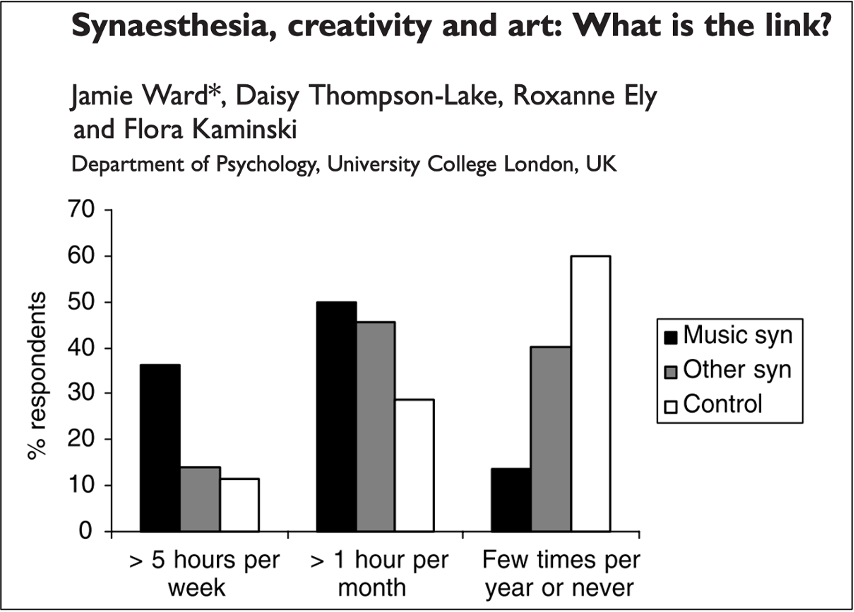
In summary, we can say that synesthesia reveals part of the perceptual complexity of the human brain, by articulating sensory experiences that, although they tend to be experienced separately in everyday life, are really part of a perceptual continuum that is integrated through neural networks. Maybe we are all partly synesthetes, but we don’t know it. Deep meditation and mindfulness can also awaken experiences of this type by modifying brain functioning. Unfortunately, we live in a world saturated with external stimuli and with work overloads that take us further and further away from the internal world. This is an invitation to look inward and connect with our sensory world, with those images that are recreated in our minds with musical, olfactory, tactile, gustatory, stimuli.
- Banissy, M. J., Jonas, C., & Cohen Kadosh, R. (2014). Synesthesia: an introduction. Frontiers in Psychology, 5. https://doi.org/10.3389/fpsyg.2014.01414.
- Grossenbacher, P. G., & Lovelace, C. T. (2001). Mechanisms of synesthesia: cognitive and physiological constraints. Trends in Cognitive Sciences, 5(1), 36–41.
- Mahendra, V., Parashos, A., Wagner, M., & Gleichgerrcht, E. (2023). A Case of Acquired Speech-to-Color Synesthesia following Traumatic Brain Injury. (P4-12.002). Monday, April 24, 4616. https://doi.org/10.1212/WNL.0000000000204108
- Luke, D. P., & Terhune, D. B. (2013). The induction of synaesthesia with chemical agents: a systematic review. Frontiers in Psychology, https://doi.org/10.3389/fpsyg.2013.00753
- Neufeld, J., Sinke, C., Zedler, M., Dillo, W., Emrich, H. M., Bleich, S., & Szycik, G. R. (2012). Disinhibited feedback as a cause of synesthesia: Evidence from a functional connectivity study on auditory-visual synesthetes. Neuropsychologia, 50(7), 1471–1477. https://doi.org/10.1016/j.neuropsychologia.2012.02.032
- Ward, J., Thompson-Lake, D., Ely, R., & Kaminski, F. (2008). Synaesthesia, creativity and art: What is the link? British Journal of Psychology, 99(1), 127–141. https://doi.org/10.1348/000712607X204164

